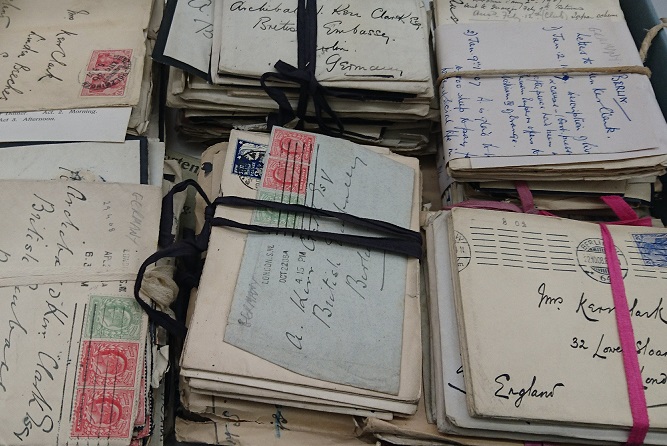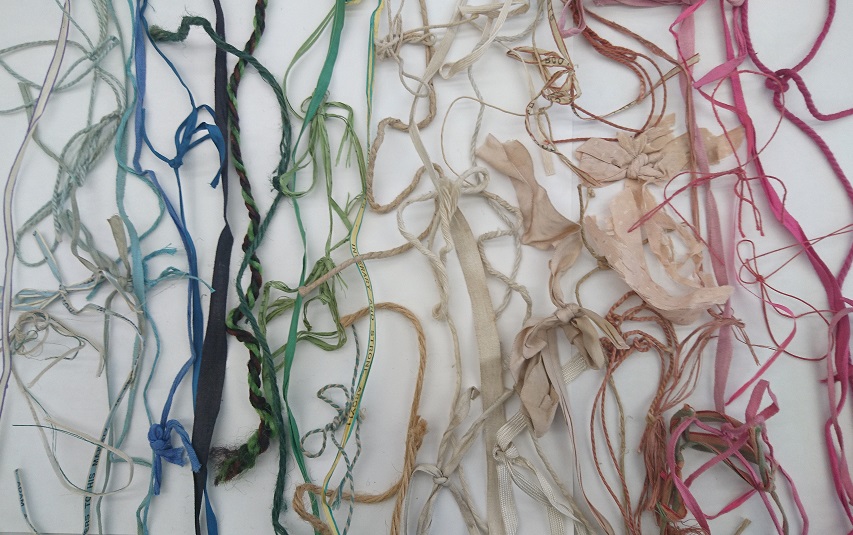When material from the archive of Archibald Clark Kerr, Baron Inverchapel – or indeed from any of the Bodleian’s modern archives – is ordered to the Special Collections reading rooms, it will most likely arrive in a greyish blue box, the papers neatly housed in blueish grey folders of the same colour. Sheets of acid-free, calcium carbonate buffered paper to separate leaves, ‘Melinex’ polyester pockets for photographs, folder titles written in 2B pencil, acrylic adhesive labels, a brass paperclip here and there – everything screams (or rather whispers… it’s a library after all) ‘archival packaging’.
BS 4971, the 2017 British Standard for the conservation and care of archive and library collections, is the Holy Grail, and no packaging material not complying with its strict rules shall ever come near our precious documents.

Material from the Edgar Wind Papers in full archival packaging armour. Blue-grey or grey-blue, the colour of the envelopes and boxes is heavily contested.
However, when archives first arrive at the Bodleian, the packaging is quite different: all kinds of boxes, cartons, baskets and trunks are used for transfer, and the papers are likely to still be in the order and condition their creator or collector stored them in – including a wide array of folders, envelopes, pockets, sheet protectors, paperclips, pins, staples, ribbons, cords and rubber bands once used to organize and protect them.
In case of the the Inverchapel Archive, almost all of the correspondence came in bundles. Hundreds, if not thousands, of letters, still folded up inside their original envelopes, sorted in little piles and tied together with pieces of string, cord or ribbon – like these exchanged between Archibald Kerr Clark Esq., then a young attaché at the British Embassy in Berlin, and Mrs. Kerr Clark, his mother in London:

All bundled up: Letters from the Archive of Archibald Clark Kerr, Baron Inverchapel, c.1908. Why are they addressed to Archibald Kerr Clark – find out here.
Whilst it was very helpful to identify runs of correspondence, and match letters with their envelopes, this organisation system had two big downsides: the letters would be difficult to access if researchers had to remove them from their envelopes first, and all the early 20th century silk, cotton, wool, hemp, jute… ribbons and cords are not very likely to be compliant with 21st century BS4971 specifications.
Consequently, quite a lot of time on the Inverchapel cataloguing project was actually spent on pre-cataloguing archival processing tasks: removing all those strings, and the rusty pins and paperclips holding together sheets of paper inside the envelopes, unfolding pages, encasing photographs in Melinex, and not least placing the flattened papers safely in archive standard folders.
After processing more than 80 correspondence boxes, the amount of ribbons, cords and strings removed from the archive was rather impressive:

A rich bounty: Ribbons, cords and strings removed from the Inverchapel material. …We should have tied them all together and measured the result – in ells, obviously!
A lot of pink. But apart from his colour preferences some of those textile fasteners also reveal some of the archive owner’s shopping habits, as these ties, probably re-used from delivery parcels, show:
- Searcy, Tansley & Co. Ltd., London – most likely a food delivery. One could speculate if H.M. Ambassador, Lord Inverchapel, had a sneaky takeaway…
- ALEXANDER MACINTYRE & CO – TWEED AND HOSIERY MERCHANTS – INVERARY AND STRONE. ARGYLL. – Proud of his Scottish heritage, and owner of the Inverchapel Estate near Lock Eck, Clark Kerr would have known where to buy his tweeds!
- BOOTS THE CHEMISTS – how people carried home their soap and aspirin before plastic bags were invented.
- G. ADAM & CO., FRUITERERS TO HIS MAJESTY, 42, NEW BOND STREET, W., TELEPHONE 2128 MAYFAIR – only the best apples and pears!
Like those shop ties, most strings and ribbons used for tying up the letter bundles seem to have been repurposed, or, like the many pink cotton bands, were haberdashery leftovers. On closer examination, the big pile of old textile fasteners reveals a remarkable variety of materials and colours:
But however pretty and colourful those tapes and ribbons may be, they still face the fate and final destination of all* old fasteners which could potentially be harmful to our precious archives – the bin.
Where ties are needed to hold bundles together, there is now archive standard unbleached cotton tape in place. Admittedly, this is less exciting than its colourful historic cousins. But it goes very well with the blueish grey/ greyish blue of our acid-free, calcium carbonate buffered boxes and folders, and most importantly: it complies with BS 4971.
*Almost all. Some end up in our Bodleian Conservation colleagues’ ‘interesting pin collection’, where they get a new life in documenting the history of stationary and
help to determine the age of undated documents.


